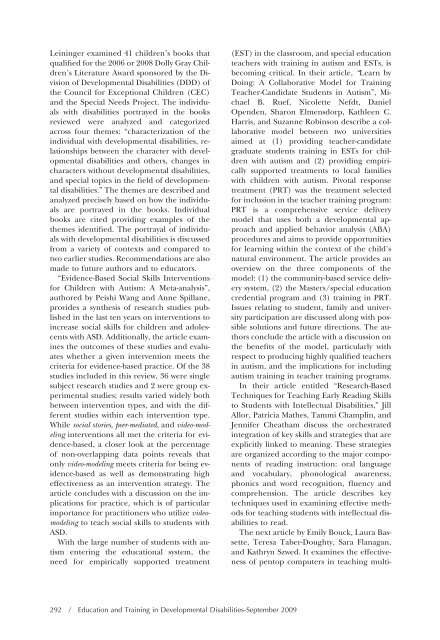Education and Training in Developmental Disabilities - Division on ...
Education and Training in Developmental Disabilities - Division on ...
Education and Training in Developmental Disabilities - Division on ...
Create successful ePaper yourself
Turn your PDF publications into a flip-book with our unique Google optimized e-Paper software.
Le<str<strong>on</strong>g>in</str<strong>on</strong>g><str<strong>on</strong>g>in</str<strong>on</strong>g>ger exam<str<strong>on</strong>g>in</str<strong>on</strong>g>ed 41 children’s books that<br />
qualified for the 2006 or 2008 Dolly Gray Children’s<br />
Literature Award sp<strong>on</strong>sored by the <str<strong>on</strong>g>Divisi<strong>on</strong></str<strong>on</strong>g><br />
of <str<strong>on</strong>g>Developmental</str<strong>on</strong>g> <str<strong>on</strong>g>Disabilities</str<strong>on</strong>g> (DDD) of<br />
the Council for Excepti<strong>on</strong>al Children (CEC)<br />
<str<strong>on</strong>g>and</str<strong>on</strong>g> the Special Needs Project. The <str<strong>on</strong>g>in</str<strong>on</strong>g>dividuals<br />
with disabilities portrayed <str<strong>on</strong>g>in</str<strong>on</strong>g> the books<br />
reviewed were analyzed <str<strong>on</strong>g>and</str<strong>on</strong>g> categorized<br />
across four themes: “characterizati<strong>on</strong> of the<br />
<str<strong>on</strong>g>in</str<strong>on</strong>g>dividual with developmental disabilities, relati<strong>on</strong>ships<br />
between the character with developmental<br />
disabilities <str<strong>on</strong>g>and</str<strong>on</strong>g> others, changes <str<strong>on</strong>g>in</str<strong>on</strong>g><br />
characters without developmental disabilities,<br />
<str<strong>on</strong>g>and</str<strong>on</strong>g> special topics <str<strong>on</strong>g>in</str<strong>on</strong>g> the field of developmental<br />
disabilities.” The themes are described <str<strong>on</strong>g>and</str<strong>on</strong>g><br />
analyzed precisely based <strong>on</strong> how the <str<strong>on</strong>g>in</str<strong>on</strong>g>dividuals<br />
are portrayed <str<strong>on</strong>g>in</str<strong>on</strong>g> the books. Individual<br />
books are cited provid<str<strong>on</strong>g>in</str<strong>on</strong>g>g examples of the<br />
themes identified. The portrayal of <str<strong>on</strong>g>in</str<strong>on</strong>g>dividuals<br />
with developmental disabilities is discussed<br />
from a variety of c<strong>on</strong>texts <str<strong>on</strong>g>and</str<strong>on</strong>g> compared to<br />
two earlier studies. Recommendati<strong>on</strong>s are also<br />
made to future authors <str<strong>on</strong>g>and</str<strong>on</strong>g> to educators.<br />
“Evidence-Based Social Skills Interventi<strong>on</strong>s<br />
for Children with Autism: A Meta-analysis”,<br />
authored by Peishi Wang <str<strong>on</strong>g>and</str<strong>on</strong>g> Anne Spillane,<br />
provides a synthesis of research studies published<br />
<str<strong>on</strong>g>in</str<strong>on</strong>g> the last ten years <strong>on</strong> <str<strong>on</strong>g>in</str<strong>on</strong>g>terventi<strong>on</strong>s to<br />
<str<strong>on</strong>g>in</str<strong>on</strong>g>crease social skills for children <str<strong>on</strong>g>and</str<strong>on</strong>g> adolescents<br />
with ASD. Additi<strong>on</strong>ally, the article exam<str<strong>on</strong>g>in</str<strong>on</strong>g>es<br />
the outcomes of these studies <str<strong>on</strong>g>and</str<strong>on</strong>g> evaluates<br />
whether a given <str<strong>on</strong>g>in</str<strong>on</strong>g>terventi<strong>on</strong> meets the<br />
criteria for evidence-based practice. Of the 38<br />
studies <str<strong>on</strong>g>in</str<strong>on</strong>g>cluded <str<strong>on</strong>g>in</str<strong>on</strong>g> this review, 36 were s<str<strong>on</strong>g>in</str<strong>on</strong>g>gle<br />
subject research studies <str<strong>on</strong>g>and</str<strong>on</strong>g> 2 were group experimental<br />
studies; results varied widely both<br />
between <str<strong>on</strong>g>in</str<strong>on</strong>g>terventi<strong>on</strong> types, <str<strong>on</strong>g>and</str<strong>on</strong>g> with the different<br />
studies with<str<strong>on</strong>g>in</str<strong>on</strong>g> each <str<strong>on</strong>g>in</str<strong>on</strong>g>terventi<strong>on</strong> type.<br />
While social stories, peer-mediated, <str<strong>on</strong>g>and</str<strong>on</strong>g> video-model<str<strong>on</strong>g>in</str<strong>on</strong>g>g<br />
<str<strong>on</strong>g>in</str<strong>on</strong>g>terventi<strong>on</strong>s all met the criteria for evidence-based,<br />
a closer look at the percentage<br />
of n<strong>on</strong>-overlapp<str<strong>on</strong>g>in</str<strong>on</strong>g>g data po<str<strong>on</strong>g>in</str<strong>on</strong>g>ts reveals that<br />
<strong>on</strong>ly video-model<str<strong>on</strong>g>in</str<strong>on</strong>g>g meets criteria for be<str<strong>on</strong>g>in</str<strong>on</strong>g>g evidence-based<br />
as well as dem<strong>on</strong>strat<str<strong>on</strong>g>in</str<strong>on</strong>g>g high<br />
effectiveness as an <str<strong>on</strong>g>in</str<strong>on</strong>g>terventi<strong>on</strong> strategy. The<br />
article c<strong>on</strong>cludes with a discussi<strong>on</strong> <strong>on</strong> the implicati<strong>on</strong>s<br />
for practice, which is of particular<br />
importance for practiti<strong>on</strong>ers who utilize videomodel<str<strong>on</strong>g>in</str<strong>on</strong>g>g<br />
to teach social skills to students with<br />
ASD.<br />
With the large number of students with autism<br />
enter<str<strong>on</strong>g>in</str<strong>on</strong>g>g the educati<strong>on</strong>al system, the<br />
need for empirically supported treatment<br />
292 / <str<strong>on</strong>g>Educati<strong>on</strong></str<strong>on</strong>g> <str<strong>on</strong>g>and</str<strong>on</strong>g> <str<strong>on</strong>g>Tra<str<strong>on</strong>g>in</str<strong>on</strong>g><str<strong>on</strong>g>in</str<strong>on</strong>g>g</str<strong>on</strong>g> <str<strong>on</strong>g>in</str<strong>on</strong>g> <str<strong>on</strong>g>Developmental</str<strong>on</strong>g> <str<strong>on</strong>g>Disabilities</str<strong>on</strong>g>-September 2009<br />
(EST) <str<strong>on</strong>g>in</str<strong>on</strong>g> the classroom, <str<strong>on</strong>g>and</str<strong>on</strong>g> special educati<strong>on</strong><br />
teachers with tra<str<strong>on</strong>g>in</str<strong>on</strong>g><str<strong>on</strong>g>in</str<strong>on</strong>g>g <str<strong>on</strong>g>in</str<strong>on</strong>g> autism <str<strong>on</strong>g>and</str<strong>on</strong>g> ESTs, is<br />
becom<str<strong>on</strong>g>in</str<strong>on</strong>g>g critical. In their article, “Learn by<br />
Do<str<strong>on</strong>g>in</str<strong>on</strong>g>g: A Collaborative Model for <str<strong>on</strong>g>Tra<str<strong>on</strong>g>in</str<strong>on</strong>g><str<strong>on</strong>g>in</str<strong>on</strong>g>g</str<strong>on</strong>g><br />
Teacher-C<str<strong>on</strong>g>and</str<strong>on</strong>g>idate Students <str<strong>on</strong>g>in</str<strong>on</strong>g> Autism”, Michael<br />
B. Ruef, Nicolette Nefdt, Daniel<br />
Openden, Shar<strong>on</strong> Elmensdorp, Kathleen C.<br />
Harris, <str<strong>on</strong>g>and</str<strong>on</strong>g> Suzanne Rob<str<strong>on</strong>g>in</str<strong>on</strong>g>s<strong>on</strong> describe a collaborative<br />
model between two universities<br />
aimed at (1) provid<str<strong>on</strong>g>in</str<strong>on</strong>g>g teacher-c<str<strong>on</strong>g>and</str<strong>on</strong>g>idate<br />
graduate students tra<str<strong>on</strong>g>in</str<strong>on</strong>g><str<strong>on</strong>g>in</str<strong>on</strong>g>g <str<strong>on</strong>g>in</str<strong>on</strong>g> ESTs for children<br />
with autism <str<strong>on</strong>g>and</str<strong>on</strong>g> (2) provid<str<strong>on</strong>g>in</str<strong>on</strong>g>g empirically<br />
supported treatments to local families<br />
with children with autism. Pivotal resp<strong>on</strong>se<br />
treatment (PRT) was the treatment selected<br />
for <str<strong>on</strong>g>in</str<strong>on</strong>g>clusi<strong>on</strong> <str<strong>on</strong>g>in</str<strong>on</strong>g> the teacher tra<str<strong>on</strong>g>in</str<strong>on</strong>g><str<strong>on</strong>g>in</str<strong>on</strong>g>g program:<br />
PRT is a comprehensive service delivery<br />
model that uses both a developmental approach<br />
<str<strong>on</strong>g>and</str<strong>on</strong>g> applied behavior analysis (ABA)<br />
procedures <str<strong>on</strong>g>and</str<strong>on</strong>g> aims to provide opportunities<br />
for learn<str<strong>on</strong>g>in</str<strong>on</strong>g>g with<str<strong>on</strong>g>in</str<strong>on</strong>g> the c<strong>on</strong>text of the child’s<br />
natural envir<strong>on</strong>ment. The article provides an<br />
overview <strong>on</strong> the three comp<strong>on</strong>ents of the<br />
model: (1) the community-based service delivery<br />
system, (2) the Masters/special educati<strong>on</strong><br />
credential program <str<strong>on</strong>g>and</str<strong>on</strong>g> (3) tra<str<strong>on</strong>g>in</str<strong>on</strong>g><str<strong>on</strong>g>in</str<strong>on</strong>g>g <str<strong>on</strong>g>in</str<strong>on</strong>g> PRT.<br />
Issues relat<str<strong>on</strong>g>in</str<strong>on</strong>g>g to student, family <str<strong>on</strong>g>and</str<strong>on</strong>g> university<br />
participati<strong>on</strong> are discussed al<strong>on</strong>g with possible<br />
soluti<strong>on</strong>s <str<strong>on</strong>g>and</str<strong>on</strong>g> future directi<strong>on</strong>s. The authors<br />
c<strong>on</strong>clude the article with a discussi<strong>on</strong> <strong>on</strong><br />
the benefits of the model, particularly with<br />
respect to produc<str<strong>on</strong>g>in</str<strong>on</strong>g>g highly qualified teachers<br />
<str<strong>on</strong>g>in</str<strong>on</strong>g> autism, <str<strong>on</strong>g>and</str<strong>on</strong>g> the implicati<strong>on</strong>s for <str<strong>on</strong>g>in</str<strong>on</strong>g>clud<str<strong>on</strong>g>in</str<strong>on</strong>g>g<br />
autism tra<str<strong>on</strong>g>in</str<strong>on</strong>g><str<strong>on</strong>g>in</str<strong>on</strong>g>g <str<strong>on</strong>g>in</str<strong>on</strong>g> teacher tra<str<strong>on</strong>g>in</str<strong>on</strong>g><str<strong>on</strong>g>in</str<strong>on</strong>g>g programs.<br />
In their article entitled “Research-Based<br />
Techniques for Teach<str<strong>on</strong>g>in</str<strong>on</strong>g>g Early Read<str<strong>on</strong>g>in</str<strong>on</strong>g>g Skills<br />
to Students with Intellectual <str<strong>on</strong>g>Disabilities</str<strong>on</strong>g>,” Jill<br />
Allor, Patricia Mathes, Tammi Champl<str<strong>on</strong>g>in</str<strong>on</strong>g>, <str<strong>on</strong>g>and</str<strong>on</strong>g><br />
Jennifer Cheatham discuss the orchestrated<br />
<str<strong>on</strong>g>in</str<strong>on</strong>g>tegrati<strong>on</strong> of key skills <str<strong>on</strong>g>and</str<strong>on</strong>g> strategies that are<br />
explicitly l<str<strong>on</strong>g>in</str<strong>on</strong>g>ked to mean<str<strong>on</strong>g>in</str<strong>on</strong>g>g. These strategies<br />
are organized accord<str<strong>on</strong>g>in</str<strong>on</strong>g>g to the major comp<strong>on</strong>ents<br />
of read<str<strong>on</strong>g>in</str<strong>on</strong>g>g <str<strong>on</strong>g>in</str<strong>on</strong>g>structi<strong>on</strong>: oral language<br />
<str<strong>on</strong>g>and</str<strong>on</strong>g> vocabulary, ph<strong>on</strong>ological awareness,<br />
ph<strong>on</strong>ics <str<strong>on</strong>g>and</str<strong>on</strong>g> word recogniti<strong>on</strong>, fluency <str<strong>on</strong>g>and</str<strong>on</strong>g><br />
comprehensi<strong>on</strong>. The article describes key<br />
techniques used <str<strong>on</strong>g>in</str<strong>on</strong>g> exam<str<strong>on</strong>g>in</str<strong>on</strong>g><str<strong>on</strong>g>in</str<strong>on</strong>g>g effective methods<br />
for teach<str<strong>on</strong>g>in</str<strong>on</strong>g>g students with <str<strong>on</strong>g>in</str<strong>on</strong>g>tellectual disabilities<br />
to read.<br />
The next article by Emily Bouck, Laura Bassette,<br />
Teresa Taber-Doughty, Sara Flanagan,<br />
<str<strong>on</strong>g>and</str<strong>on</strong>g> Kathryn Szwed. It exam<str<strong>on</strong>g>in</str<strong>on</strong>g>es the effectiveness<br />
of pentop computers <str<strong>on</strong>g>in</str<strong>on</strong>g> teach<str<strong>on</strong>g>in</str<strong>on</strong>g>g multi-

















